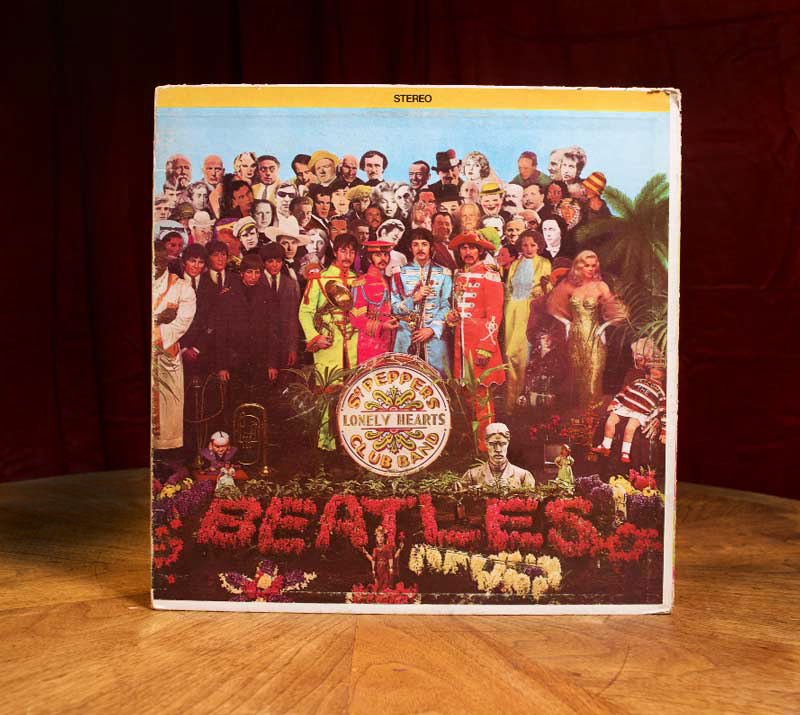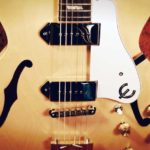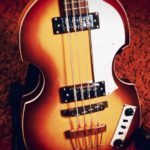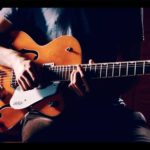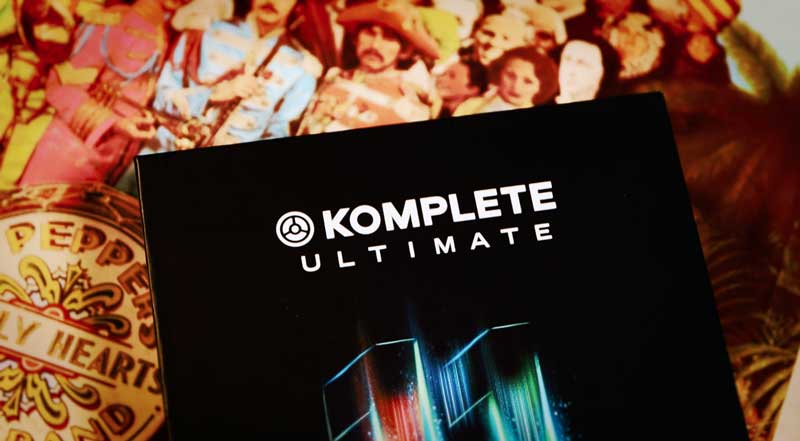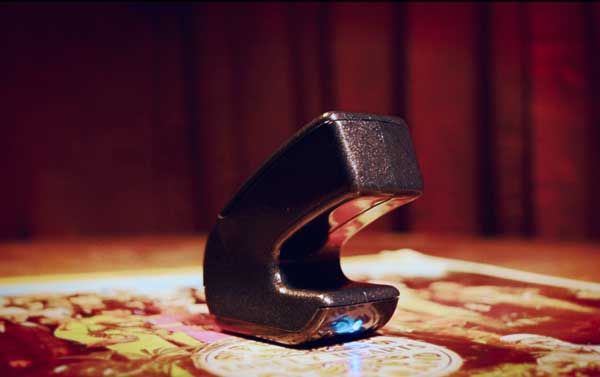“You’ve NEVER heard Sgt. Pepper’s Lonely Hearts Club Band before?”
I used to hear this sentence countless times growing up. But to be honest, I didn’t enjoy the music of the Beatles all that much then. The only problem was that I thought I knew their music – “She Loves You” right? I couldn’t have been more wrong. My first full experience with the music of the Beatles happened when I got a copy of Revolver from a friend. Needless to say, my mind was absolutely blown. I quickly grabbed up any other albums I could find, becoming curious about what else I was missing.
…And then came Sgt. Pepper’s Lonely Hearts Club Band. I listened to it, and listened again. And again. And again. The vocal harmonies, the chord progressions, the unique instrumentation…it had everything I was looking for, and I was hooked.
Of course, I am not alone in my longstanding obsession with Sgt. Pepper’s – it has sold over 32 million copies as of today and was the first ever rock album to win an Album of the Year Grammy in 1968. It also won the Grammy for Best Engineered Recording, Best Album Cover, and Best Contemporary Album, and the accolades don’t stop there. In 2003 it had the honor of topping Rolling Stone’s “500 Greatest Albums of All Time” list. Music scholar David Scott Kastan called the album “the most important and influential rock and roll album ever recorded.“ The chances are high that any musician you know will be a huge fan. It simply can’t be ignored, and can’t be explained.
The album was a game-changer for several reasons: It blended serious music with pop sensibilities, is credited as one of the first concept albums and encouraged the emphasis on the album format instead of singles, and introduced an several innovations in recording, some of which are still being used today. While I won’t be able to cover the entire album here, I will be focusing on the four tracks that we chose to recreate and feature for our Legends of Tone video. We thought it fitting to make the video as Sgt. Pepper’s just celebrated its 50th anniversary earlier this month.
Learn More About The Beatles’ Gear on zZounds
The Title Track(s)
In 1966, the Beatles were in a bad place. They were tired of the super stardom, and their concert performances started to take a toll. They simply didn’t have adequate live sound amplification to be heard over their rabid fans. This came to a crux when they played at the legendary Nippon Budokan arena in Japan – the audience was so quiet they could actually hear how terrible they were beginning to sound live. This was upsetting to the band, with a breakup looming on the horizon. They were burnt out from the touring life and felt it was stifling their creativity.
The opening track, “Sgt. Pepper’s Lonely Hearts Club Band” sets the stage for the concept of the entire album. It was supposed to be about the fictional band of the same name, which became an alter ego of sorts. This concept allowed the Beatles to take risks and creative liberties that they felt they previously couldn’t before based on their usual pop and rock-oriented sound.
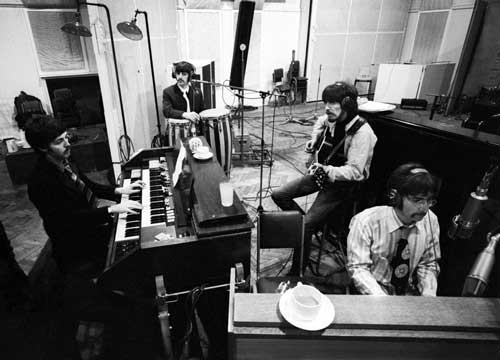
The recording of the title track
The song itself is notable for its use of power chords, seventh chord sequences, and truly over-the-top distorted guitar tones. Some consider the song to be one of the earliest “fusion” style songs because it blends distorted guitar tones with a brass ensemble. It also features Paul McCartney’s bass tone recorded direct for the first time, giving it a much more full sound that could be mixed in more interesting ways than before.
The Jimi Hendrix Experience had played a show at the Saville Theatre in London and performed a version of the title track just three days after the album was released. George Harrison and Paul McCartney were at the concert as well, being fans of his music.
The reprise of the Sgt. Pepper’s track was similar musically, but had an increased tempo and a much more in-your-face Ringo drum performance. The band decided to write the song after their assistant Neil Aspinall recommended that the fictional Sgt. Pepper band make another appearance near the end of the album. It was to be a sort of bookend bringing it all together. Take notice of the multi-layered vocal harmony parts present on the track – it gives it a much denser sound than the album-opening version.
Within You, Without You
This side two album opener is one of, if not the most, unique of the Beatles’ catalogue. It had come about in 1966 when George Harrison expressed the desire to leave the band if they went out on tour again. He took a six-week trip to India in order to pursue his newfound fascination of Eastern philosophy and culture. “Within You, Without You” was inspired by Hindustani classical music and Harrison’s interest in the Hindu Vedas, and created a complete shift in mood of the album. The song’s main melody incorporates the Khamaj scale, which is similar to the Mixolydian mode in Western music. This was performed over a drone of the root note and fifth, a common practice with this style of music that creates a more ambiguous harmonic effect – it is neither major nor minor. Interestingly, the song was recorded in C major but ended up a bit too long in length (6:25), so the tape was sped up to and bring the song to a more reasonable 5:05. The song ended up in the key of C#, a semitone higher.
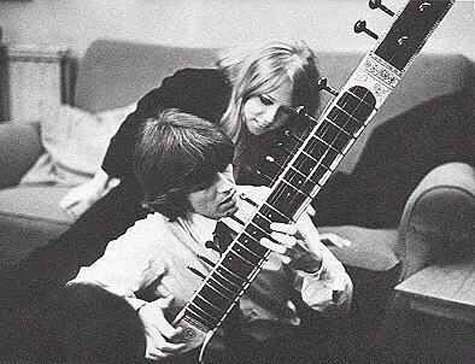
George Harrison playing his sitar before the recording
Lyrically, Harrison had been inspired by a conversation that he had over dinner at artist Klaus Voormann’s home, where they discussed a metaphysical space between people that prevents them from realizing the natural unity found among all things. This prompted him to write the opening lyrics “We were talking about the space between us all.”
From there, Harrison incorporated his newfound instrument into the mix: the sitar. Harrison had learned the sitar while under the tutelage of none other than Ravi Shankar, easily India’s most famous sitarist. In September and October of 1966, Harrison and his wife Pattie Boyd visited Shankar and his other students in Bombay, but once the press got word of his arrival, fans flocked to meet him, and they decided to retire to a houseboat on Dal Lake in Kashmir instead. There, he learned of the Hindu religious texts and was introduced to meditation. This stage in Harrison’s life opened the door to begin writing his featured song.
For the recording of “Within You, Without You,” Harrison assembled musicians from the Asian Music Circle, an organization dedicated to spreading the art, music, and culture of India and other Asian countries to London. Harrison and Beatles’ aide Henry Aspinall each played tamburas, a traditional Indian instrument, and the contributing Indian musicians played dilruba, another tambura, tabla, and the swarmandal.
Harrison had organized the session at Abbey Road Studios, where he set up tapestries, incense, and low lighting to set the mood. A student of Shankar’s who attended the recording session, John Barham, said that Harrison “had the entire structure of the song mapped out in his head,” and taught the dilruba player the melody to the song by singing it to him.
Once they recorded their basic tracks to the song, Harrison eventually returned to record his vocals, and his famous call-and-response sitar solo. That same day, they recorded the string orchestrations, which were written by George Martin for eight violins and three cellos. Harrison insisted that it closely mimic the inflections and stylistic additions of the dilruba parts that they had recorded in the earlier sessions. In my opinion, the string orchestrations found there are some of the most clever and powerful of the whole record and add an unspeakable amount of depth to an already superbly textured recording.
A Day in the Life
This track is considered to be one of the most famous the Beatles had ever recorded, which is no small claim. When have you heard musicians from the London and Royal Philharmonic Orchestras play aleatoric music intended to sound as if the apocalypse was nearing? When have you heard Ringo use so many tasty drum fills? Probably never. The point is, the song is a downright masterpiece and was an easy choice to include both here, and in our demo video.
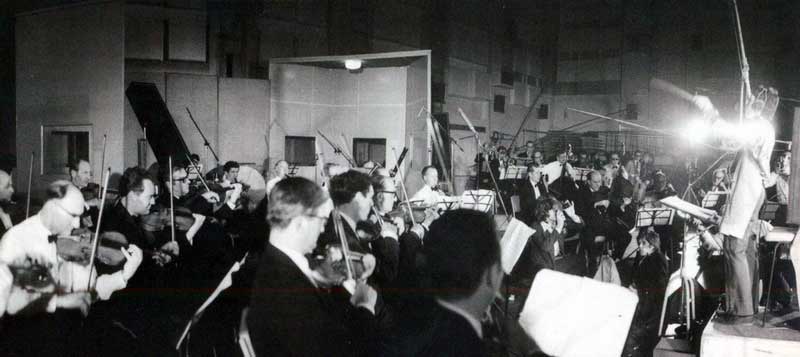
Paul conducting the 40-piece orchestra on a Day in the Life
The first two verses of the song were based around the death of Tara Browne, the heir to the Guinness beer company, when he crashed his car in 1966. This accident prompted John Lennon to write lyrics loosely based around the event. A copy of the Daily Mail newspaper that John Lennon had propped upon his piano also contributed to the song’s lyrics. “There was a paragraph about 4000 potholes in Blackburn, Lancashire.” Apparently the rest wrote itself.
John Lennon’s vocals also have a particularly dreamy quality to them, which came about due to his desire to sound like Elvis on “Heartbreak Hotel.” They achieved this by putting 90 milliseconds of tape echo on his vocal track, giving it a fast slapback delay effect. It’s a slick effect that you probably didn’t even notice was there – a hallmark of The Beatles’ ingenuity in recording and sound. Here’s a clip of the effect being put into action during a recreation of the track:
A personal favorite moment of mine happens during the “dream sequence” portion of the track. The nickname of the song’s section came about because it follows the famous lyric in the bridge “found my way upstairs and had a smoke/somebody spoke and I went into a dream.” What follows is his apparent dreamlike state, which features distant reverb-laden vocals and a supremely catchy bassline to boot. It’s replete with large orchestral buildups and a memorable brass conclusion to the section that give the tune tons of depth and grandeur. It’s a perfect way to segue back into the final verse, which is almost forgotten amid all the dense changes the song brings up to that point.
The previous “dream” lyrics, coupled with the line, “I’d love to turn you on” during the verses actually got the song banned on BBC radio for the apparent encouragement of drug use. It wouldn’t be played again until March 13th, 1972.
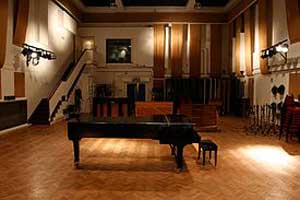
Abbey Road’s Room 2 where the final chord was recorded
At the conclusion of the tune, it famously has a massive piano climax chord that sounds enormous. But originally, this was not going to be part of the song. At first, they assembled a small group that was to hum a final sustained note, but once it was recorded, everyone expressed concerns that it wasn’t as dramatic as they had hoped it would be. The solution was to play a final piano chord, but only recording one was unlikely to achieve the desired intensity that the end of the album needed.
On February 22nd, 1967, Lennon, Starr, McCartney, George Martin, and Mal Evans, their assistant, entered the larger Room 2 of Abbey Road Studios to perform the final E Major chord on three separate pianos at once, with George Martin performing the chord on a harmonium. The chords ring out for over 40 total seconds, an almost impossibly long time, because of a clever trick: they raised the recording volume steadily as the vibration faded out, creating the illusion that the chords resonated at full intensity for that long. Apparently the recording level was so high that by the end of it, you could hear a chair squeaking, and papers rustling in the distance. It is regarded as one of the single most famous chords ever recorded.
Our Video
When we here on the video team set out to record our versions of these tunes, we knew we had our work cut out for us. A couple of key pieces of gear were used, and many are affordable and readily available. For starters, we of course used an Epiphone Casino hollowbody guitar, a favorite of John Lennon’s, to record the guitar parts on the two “Sgt. Pepper’s” tracks. We liked how we could really get interesting distortion tones when pushing the hollowbody to its limits.
- Epiphone Casino
- Hofner HIBB Ignition Bass
- Gretsch G5420
A crucial tool was the Native Instruments Komplete 11 software package, which contains the Kontakt 5 Library with over 43 GB of samples and over 1,000 instruments. For all tracks (except “Within You, Without You”) we used the Abbey Road ’60s Drummer sample to nail the Ringo sound.
What Komplete really excelled at though, was giving us a way to get all of the special effect sounds of Sgt. Pepper’s that we initially weren’t sure how to achieve. For instance, on “A Day in the Life,” we needed a really good set of strings and horns to produce the famous chaotic orchestrations. The Kontakt library has a superb collection of sounds found in the Session Strings Pro sample set, as well as the Session Horns Pro set. Additionally, we used the Symphony Essentials Woodwind Ensemble package to round things out. The song wouldn’t have been complete without a great grand piano sound, and so we used The Grandeur grand piano sample and tweaked it to taste.
The most interesting usage of the software though, was on “Within You, Without You.” Naturally, this tune was the most unique in instrumentation. The Kontakt 5 Library came in handy with their India Discover Series, offering us great Sitar, Tablas, Tanpura, and Santur samples to fill out our track appropriately. It really did make all the difference in getting the right aesthetic for the song down.
We made an all-instrumental version of the vocal line with a mildly overdriven Gretsch G5420 guitar running through a Vox AC15 amplifier. I prominently featured the Heet Sound EBow Plus in order to have infinite sustain and the ability to create heavy glissando effects similar to how traditional Indian music is played. My favorite sound we achieved was with the EBow and an EHX POG2 Polyphonic Octave Generator set to an octave down. With the Vox AC15 turned up, I was able to simulate with high accuracy the sound of the cellos on the original recording by moving the EBow quickly toward the pickups. This increases the overall gain of the signal, further distorting our AC15 and creating a pleasant bow “scraping” sound. Various other articulations were employed, including using a slide with the EBow for further microtonal inflections. Though The Beatles primarily used the Vox AC30 as their amp of choice, we had an easier time pushing the similarly voiced AC15 into overdrive.
Truly Legendary
Sgt. Pepper’s needs no introduction, nor conclusion. It is widely considered to be one of, if not the single most influential album of any genre. I can still put the album on and listen to it over and over even after all these years. The tunes have such depth that it begs repeat listens, often allowing a chance to catch a harmony or instrument you may not have even ever heard in the mix before. It is a testament to its true greatness how it has stood the test of time, and likely will continue to do so for years to come.
Check out our video at the top of the page to see our recreations of these famous tunes!

